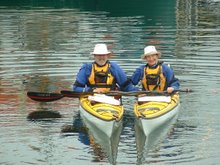When we awoke this morning, there was a change. The soothing sounds of the nearby stream that had lulled us to sleep were the same, but they masked the sound of rain this morning. Nevertheless, we jumped into the car and continued our drive southwards.
In speaking with the hotel staff at the Glomfjord Hotel, we learned a little of the significance of the hydro power plant located nearby, and its connection to the Svartisen Glacier. Work on the original power house at Fykan, a massive and proud stone structure, was started in 1912 and completed in 1920. It must have been quite a challenge to build this plant in such difficult terrain, particularly the penstock pipelines down the mountainside from the Svartisen reservoir. Everything had to be carried on the backs of the workers 700 m up the mountainside, apparently often with loads of up to 50 kg. The presence of abundant and inexpensive power attracted industry, and Glomfjord became an industrial centre before WWII.
During WWII, small group of allies trekked across mountains from two fjords further south to stop power generation to German industry. Only 4 of the allies survived, but their mission was successful. There is now a high mountain trail called the ‘Saboteur Route’ from Fjellveien to Nedre Navervann, including “The Steps” … all 1127 of them. The weather conditions and our timeline did not permit us to explore this historical route.
To get to the old power plant, you take a right turn part way through one of the tunnels on Highway 17, i.e., interesting to find an intersection in the middle of a tunnel.
After the war, the old power plant was repaired. It continued producing power for industry until 1998 when a new plant was completed. The new plant was built a little further south in Holandsfjord in the centre of a mountain. Water is fed to the plant from two large rock fill dams with impermeable cores of asphalt concrete. The Storglomass dam is 128 high and 820 m long; the Hotmass dam is 60 m high and 380 m long. Additionally, the new power plant is fed by 45 tunnels through the adjacent mountains to collect water from each of the nearby watersheds that are supplied by the Svartisen Glacier, a drainage area of about 554 km2. The Storglomvann reservoir holds almost 3.5 billion m3. Annual production is 2170 Gwh (million kilowatt hours).
We had an exciting drive up to the larger dam along a side road that took us up through many twists and turns, and through two unpaved tunnels well above the snow and tree line. The road inside the second tunnel was so steep that we needed to use 2nd gear all the way through it. We were unable to reach the smaller dam because the road was still buried in winter snow.
The skies were gray, and the rain was COLD as we darted in and out of the car to grab a photo here and there. We arrived at the Svartisen Glacier info centre in these weather conditions, and here we had to decide whether or not it was worth taking the boat trip and hike to the glacier. Visibility was not particularly good. In the end, we decided that we were here, and that we should ‘just do it’. The boat ride over was warm and comfortable, and it generally only drizzled during out walk to the glacier centre. After drying out over a snack of Norwegian pancakes with strawberry sauce and sour cream, we began hiking back to the boat in the pouring rain. Fortunately, we did not get too far before being picked up by a service truck that was going down to meet the boat. We did get to see the lower half of the Svartisen Glacier through the rain and clouds, and we did enjoy our Norwegian pancakes … it was worth the trip across the fjord.
After 7 more tunnels, including one that was 7.6 km long, 2 ferry crossings, and many up, downs and twists, we reached Nesna. With the weather as it was, we could only catch glimpses of the scenery. According to the map, we were passing mountains that were 900 to 1500 m high lost high into the clouds. A lot of the land along the coastline was devoted to farming, so it was interesting to see how land use was optimized from the shoreline to the lower slopes of the mountains. During our ferry crossing Jektvika to Kilboghamn, we re-crossed the Polarsirkelen, Arctic Circle, this time heading south.
The last part of a day’s journey took us over a pass in the clouds with visibility of only 100 m, and strong winds, before we descended to Nesna and found a place to stay.
The highlight of the day was a surprise phone call from our son, Eric.
Friday, June 15, 2007
Subscribe to:
Post Comments (Atom)

No comments:
Post a Comment